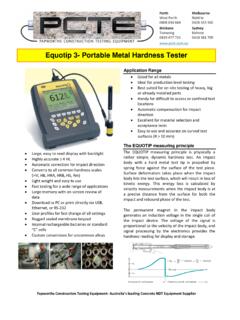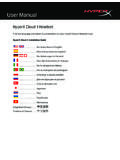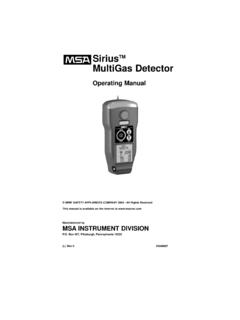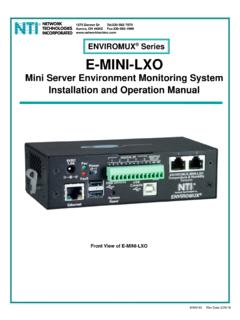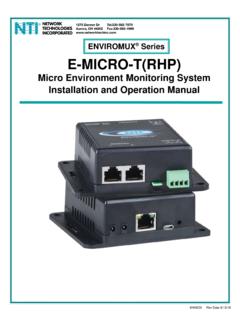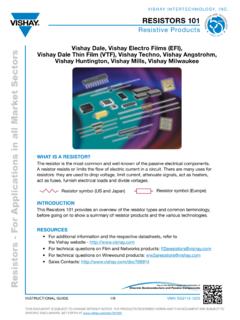Transcription of Betonprüfhammer Bedienungsanleitung Scléromètre à béton …
1 BedienungsanleitungOperating InstructionsMode d emploiBetonpr fhammerConcrete Test HammerScl rom tre b tonN/NR - L/LRN/LNR/LRPROCEQ SARiesbachstrasse 57 Postfach 936CH-8034 Z richSwitzerlandTel.:+41 (0)1 389 98 00 Fax:+41 (0)1 389 98 nderungen vorbehaltenSubject to changeSous r serve de modificationsCopyright 2002 by PROCEQ SA ZURICH2002 05 030 D/E/FEnglishvakatEnglish 2002 PROCEQ SAContents1 Contents1 Safety .. 2 General Information .. 2 Liability .. 2 Safety Regulations .. 3 Standards and Regulations Applied .. 32 Measurement .. 4 Measuring Principle .. 4 Measuring Procedure .. 4 Outputting and Evaluating Data.
2 6 Conversion Curves .. 6 Factors Affecting the Values .. 103 Maintenance .. 12 Performance Check .. 12 Cleaning After Use .. 12 Fitting a New Recording Paper Roll .. 12 Maintenance Procedure .. 134 Data .. 16 Form of Delivery .. 16 Accessories .. 16 Technical Data .. 162 Safety 2002 PROCEQ InformationThe concrete test hammer is designed according tostate-of-the-art technology and the recognized safetyregulations. Please read through these operating in-structions carefully before initial startup. They containimportant information about safety, use and maintenanceof the concrete test UseThe concrete test hammer is a mechanical device usedfor performing rapid, non-destructive quality testing onmaterials in accordance with the customer's specifica-tions; in most cases, however, the material involved device is to be used exclusively on the surfaces tobe tested and on the testing "General Terms and Conditions of Sale andDelivery" apply in all cases.
3 Warranty and liability claimsarising from personal injury and damage to property can-not be upheld if they are due to one or more of the follo-wing causes:- Failure to use the concrete test hammer in accordancewith its designated use- Incorrect performance check, operation and mainte-nance of the concrete test hammer- Failure to adhere to the sections of the operating instructions dealing with the performance check, ope-ration and maintenance of the concrete test hammer- Unauthorized structural modifications to the concrete test hammer- Serious damage resulting from the effects of foreign bodies, accidents, vandalism and force Information- Perform the prescribed maintenance work on Carry out a performance check once the maintenance work has been Handle and dispose of lubricants and cleaning agents OperatorsThe concrete test hammer is not allowed to be operatedby children and anyone under the influence of alcohol,drugs or pharmaceutical 2002 PROCEQ SASafety3 Anyone who is not familiar with the operating instructionsmust be supervised when using the concrete test IconsThe following icons are used in conjunction with allimportant safety notes in these operating !
4 This note indicates a risk of serious or fatal injury in the event that certain rules of behavior are !This note warns you about the risk of materialdamage, financial loss and legal penalties ( loss of warranty rights, liability cases, etc.).This denotes important and Regulations Applied- ISO/DIS 8045 International- EN 12 504-2 Europe- ENV 206 Europe- BS 1881, part 202 Great Britain- DIN 1048, part 2 Germany- ASTM C 805 USA- NFP 18-417 France- B 15-225 Belgium- JGJ/ T 23-2001 China- JJG 817-1993 China4 Measurement 2002 PROCEQ PrincipleThe device measures the rebound value R. There is aspecific relationship between this value and the hardnessand strength of the following factors must be taken into account whenascertaining rebound values R:- Impact direction: horizontal, vertically upwards or downwards- Age of the concrete- Size and shape of the comparison sample (cube, cylinder)Models N and NR can be used for testing:- Concrete items 100 mm or more in thickness- Concrete with a maximum particle size < 32 mmModels L and LR can be used for testing.
5 - Items with small dimensions ( thin-walled items with a thickness from 50 to 100 mm)If necessary, clamp the items to be tested prior to measurement in order to prevent the material Items made from artificial stone which are sensitive to impactsPreferably perform measurements at temperatures between 10 C and 50 C ProcedureThe items (in brackets) are illustrated in Fig. on page 5. Perform a few test impacts with the concrete test hammer on a smooth, hard surface before taking any measurements which you are going to evaluate. Use the grindstone tosmoothen the test Preparing the test surfaceWarning!The impact plunger (1) generates a recoil when it deploys.
6 Always hold the concrete test hammer in both hands! Position the concrete test hammer perpendicular to the test surface. Deploy the impact plunger (1) by pushing the concretetest hammer towards the testsurface until the pushbutton springs the impact plunger (1) (model NR)<English 2002 PROCEQ SAMeasurement5 Danger!Always hold the concrete test hammer in both hands, perpendicular to the test surface, before you trigger the impact! Each test surface should be tested with at least 8 to 10 individual impact points must be spaced at least 20 mm apart. Position the concrete test hammer perpendicular to and against the test surface.
7 Push the concrete test ham-mer against the test surface at moderate speed until the impact is the test (illustration shows model NR) If you are using models N and L, press the pushbutton(6) to lock the impact plunger (1) after every read off and note down the rebound value R indi-cated by the pointer (4) on the scale (19). If you are using models NR and LR, the rebound valueR is automatically printed on the recording paper. It isonly necessary to lock the impact plunger (1) using thepush button (6) after the last the test result from the scale (19) on models N and L141966 Measurement 2002 PROCEQ and Evaluating N and LAfter every impact, the rebound value R is displayedby the pointer (4) on the scale (19) of the NR and LRThe rebound value R is automatically registered on therecording is possible to record about 4000 test impacts on the average of the 8 10 rebound values R whichyou have not include values which are too high or too low (the lowest and highest values) in your calculation of the average value.
8 Determine which conversion curve is appropriate forthe selected body shape (see Fig. to Fig. , page 7 to page 9). Then, using the average reboundvalue Rmand the selected conversion curve, read off the average compressive the impact direction!The average compressive strength is subject to a dispersion ( N/mm2to 8 N/mm2). of the Conversion CurvesThe conversion curves (Fig. , to Fig. ) for the con-crete test hammer are based on measurements taken on very many sample cubes. The rebound values R ofthe sample cubes were measured using the concretetest hammer. Then the compressive strength was ascer-tained on a pressure testing machine.
9 In each test, atleast 10 test hammer impacts were performed on oneside of the test cube which was lightly clamped in of the Conversion Curves- Standard concrete made from Portland or blast furnaceslag cement with sand gravel (maximum particle size dia. 32 mm)- Smooth, dry surface- Age: 14 - 56 daysEmpirical values:The conversion curve is practically independent of the:- Cement content of the concrete,- Particle gradation,- Diameter of the largest particle in the fine gravel mixture, providing the diameter of the maximum particle is < 32 mm,- Water/cement ratio<<English 2002 PROCEQ SAMeasurement7 Conversion Curves, Concrete Test Hammer Model N/NRConcrete pressure resistance of a cylinder after 14 - 56 daysFig.
10 N/NR: Conversion curves based on the average compressive strength of a cylinder and the rebound value : Average pressure resistance of a cylinder(probable value)The concrete test hammers shown in Fig. and Fig. indicate the impact Curves, Concrete Test Hammer Model L/L RConcrete pressure resistance of a cylinder after 14 - 56 daysFig. L/LR: Conversion curves based on the average pressure resistance of a cylinder and the rebound value RLimits of Dispersionfckcyl.: The max. and min. values are set so 80 % of all test results are value RRebound value R8 Measurement 2002 PROCEQ SAConversion Curves, Concrete Test Hammer Model N/NRConcrete pressure resistance of a cube after 14 - 56 N/NR: Conversion curves based on the average compressive strength of a cube and the rebound value Rfckcubem: Average pressure resistance of a cube (probable value)The concrete test hammers shown in Fig.
